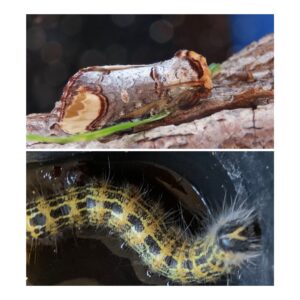This year’s moth trapping event was held on 9th August. Logistical problems meant it couldn’t be held on Seaford Head as originally planned but two members kindly stepped into the breach and offered their gardens as alternative locations. Before going any further, and in case anyone is concerned- NO MOTHS WERE HARMED DURING THIS ACTIVITY!
Moths are attracted to a light source, fall into the trap and if all goes well, stay there until the morning. After posing for a photo shoot they are identified, then either fly off to freedom or stay snug and safe in the opened trap until the next evening.
Our first stop was at Clare’s where she demonstrated two different kinds of trap and we all had a go at ID. There was a good variety of moths including several flamboyant Jersey Tigers, the wonderful Buff Tip (pictured below) which camouflages itself most effectively as a silver birch twig and possibly the most interesting, a Small China Mark. The larvae of this moth are semi-aquatic and build floating cases from fragments of their food plant, duckweed.
We then migrated en masse to the garden of Mike and Jenni in a different part of Seaford where we had a good look at their night’s ‘catch’. Here the highlight was a Starwort moth (pictured above) which none of us had ever seen before. Moths have the most wonderful names often descriptive of their appearance or their larval food plant but sometimes named for no discernible reason at all!
We also had a look at some of the books that help with identification as well as websites and apps. When identifying species most of us use a combination of traditional methods and more modern technology – once we’re over the feeling that this is somehow cheating!
A few members trap regularly, submitting their finds to irecord for ID confirmation and in so doing contributing to a national database – Citizen Science! Society records go back many years -Richard Eves is now our chief Moth Recorder, keeping tabs on what is found in Seaford Parish. We’re now up to an all time total of 742 moths with 328 spotted so far this year, of which 28 are new records! However with approximately 2,500 moths to be found in the UK we have a way to go yet.
Personally, I wasn’t particularly interested in moths until attending a society event and deciding to have a go. I borrowed the Society’s trap one night and the rest as they say is history. Please ask if you would like to have a try. The Robinson Trap (bottom photo above) is available to members to borrow. You never know, you may get trapped into trapping too!
This news story was originally published by the Seaford Natural History Society. Find out more about how to join, or come along to their events, on their website






